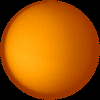
Saturn is the 2nd largest planet with a mass of 95 times that of Earth and a radius of 9 times that of Earth. Saturn's density is the lowest in the solar system at 0.68 gm/cm3. The atmosphere is similar to that of Jupiter. Saturn is best known for its spectacular ring system (although all the Jovian planets have rings).
Saturn also has many moons. Titan is the most interesting because it has an atmosphere made of 99% nitrogen that may be similar to that of the primitive Earth.
 Titan. Second largest moon in the solar
system. Radius 2575km. Titan is the only satellite which has atmosphere. Its
atmosphere is made of nitrogen and methane. Titan's high density (1.9 g/cm3)
implies 50-50 composition of ice and rock.
Titan. Second largest moon in the solar
system. Radius 2575km. Titan is the only satellite which has atmosphere. Its
atmosphere is made of nitrogen and methane. Titan's high density (1.9 g/cm3)
implies 50-50 composition of ice and rock.
Enceladus. Radius 250km. Relatively smooth
surface indicates recent geological activity. Grooves (tens of kilometers long)
imply that the crust was deformed by internal heat. A hot interior can heat and
melt surface ice.